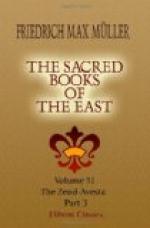This constant struggle of the two divinities with their armies of good and bad spirits formed the background of Zoroastrian supernaturalism. The worship of the Persians was the worship of the powers of Nature, and especially of fire, although water, earth, and air, are also addressed in the litanies of the “Zend-Avesta.” The down-falling water and the uprising mist are thus spoken of in one passage:—
As the sea (Vouru-kasha) is the gathering place of the waters, rising up and going down, up the aerial way and down the earth, down the earth and up the aerial way: thus rise up and roll along! thou in whose rising and growing Ahura Mazda made the aerial way.
The sun is also invoked:—
Up! rise up and roll along!
thou swift-horsed Sun, above Hara
Berezaiti, and produce light
for the world.
The earth was considered to be polluted by the burial of the dead, who are to be exposed in high places to be devoured by the birds of the air and swept away by the streams into which the rain should wash their remains. But the principal subjects of Zoroaster’s teaching was the struggle between Ormuzd and Ahriman and their hosts “The Holy Immortal Ones” and the Devas, or evil spirits. This is the basis of all the activities of the world and, according to Zoroaster, is to result in a triumph of the good.
Zoroaster taught that the life of man has two parts, that on earth and that beyond the grave. After his earthly life each one should be punished or rewarded according to his deeds.
The “Zend-Avesta” cannot be dated earlier than the first century before our era. It consists of four books, of which the chief one is the Vendidad; the other three are the liturgical and devotional works, consisting of hymns, litanies, and songs of praise, addressed to the Deities and angels of Goodness.
The Vendidad contains an account of the creation and counter-creation of Ormuzd and Ahriman, the author of the good things and of the evil things in the world. After this follows what we may call a history of the beginnings of civilization under Yima, the Persian Noah. The revelation is described as being made directly to Zoroaster, who, like Moses, talked with God. Thus, in the second fargard, or chapter, we read:—
Zarathustra (Zoroaster) asked Ahura Mazda (Ormuzd):—
“O Ahura Mazda (Ormuzd), most beneficent Spirit, Maker of the material world, thou Holy One! Who was the first mortal, before myself, Zarathustra, with whom thou, Ahura Mazda, didst converse, whom thou didst teach the religion of Ahura, the Religion of Zarathustra?”
Ahura Mazda answered:—




